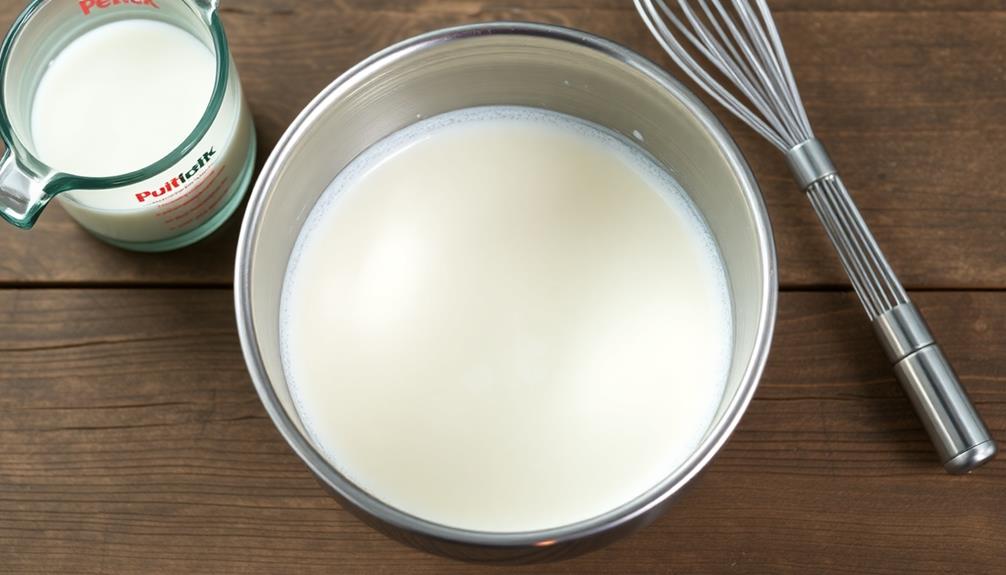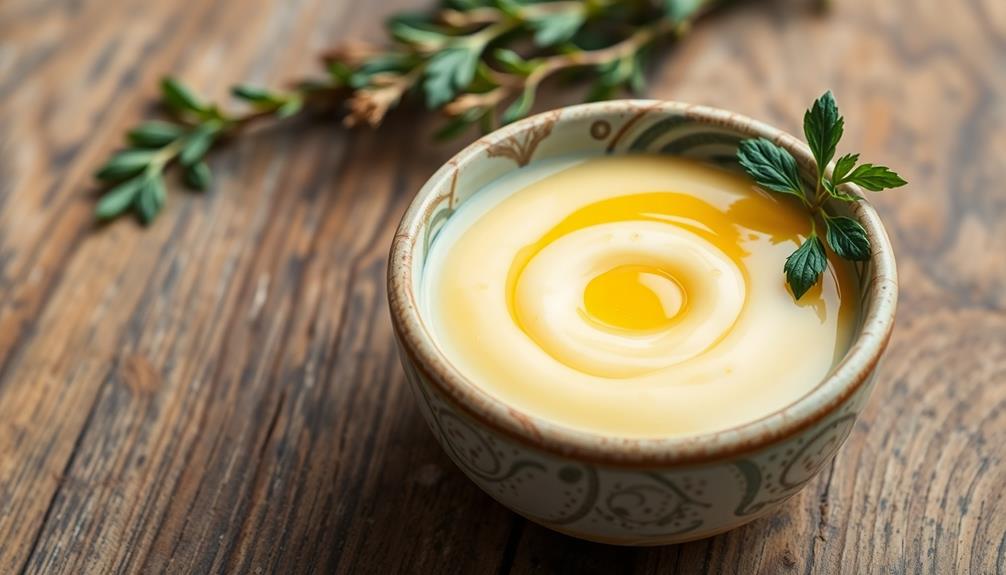Dive into the flavorful world of homemade hummus, a Middle Eastern dip with a rich history spanning thousands of years. This easy recipe calls for simple ingredients like chickpeas, tahini, lemon juice, and garlic, blending them into a silky-smooth consistency. Start by thoroughly draining and rinsing the chickpeas to remove any starch, then process the tahini until creamy. Incorporate the aromatic garlic and tangy lemon juice, and finish with a blend of spices like cumin and paprika. The result is a nutritious and versatile dip that's perfect for pairing with pita, veggies, or crackers. Discover more about the customization and health benefits of this beloved hummus recipe.
Key Takeaways
- This easy homemade hummus recipe requires simple, readily available ingredients like chickpeas, tahini, lemon juice, and garlic.
- The step-by-step instructions outline the essential techniques for achieving a smooth, creamy texture, including thoroughly draining and rinsing the chickpeas.
- Customization options are provided, allowing you to experiment with different spices, roasted vegetables, herbs, and even sweet variations.
- Homemade hummus is a nutritious snack or appetizer, offering a good source of protein, fiber, and essential vitamins and minerals.
- The recipe highlights the benefits of making hummus at home, including the ability to control ingredients, achieve a healthier alternative, and explore unique flavor combinations.
History

Where did hummus, the beloved Middle Eastern dip, originate? Hummus has a rich history dating back thousands of years, with its roots firmly planted in the culinary traditions of the Levant region. The earliest known references to a dish resembling modern-day hummus can be found in 13th-century Arabic cookbooks, though its origins likely stretch even further back in time.
The word "hummus" itself is Arabic, meaning "chickpeas," the key ingredient that gives this creamy spread its signature texture and flavor.
Over the centuries, hummus has evolved, with each region and culture adding its own unique twist, whether it's the addition of tahini, garlic, lemon juice, or spices.
Today, hummus has become a global sensation, enjoyed by people of all backgrounds as a versatile and healthy snack or appetizer. Its enduring popularity is a testament to the timeless appeal of this simple, yet delicious, Middle Eastern delicacy.
Recipe
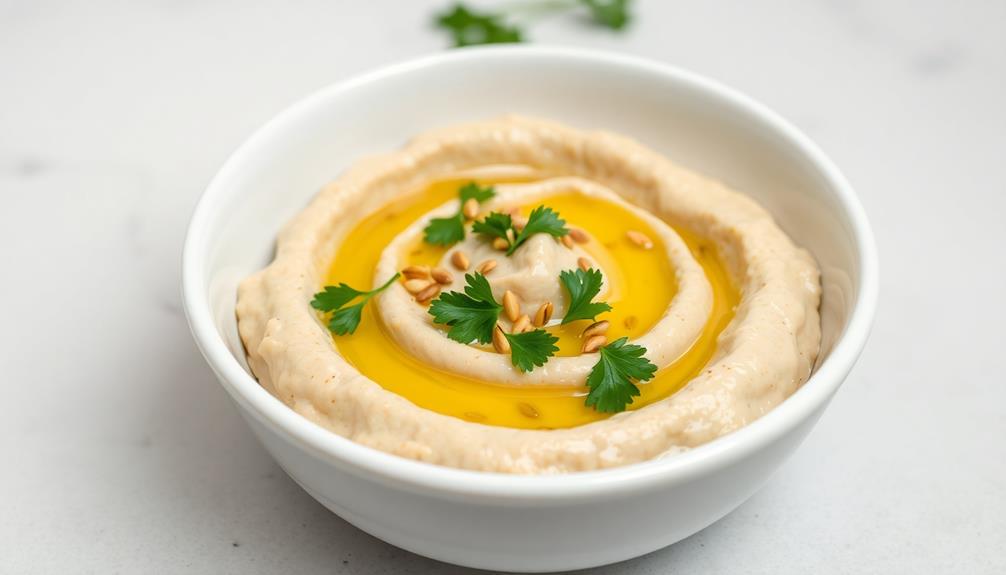
Homemade hummus is a delicious and nutritious dip that can be enjoyed as a snack, appetizer, or accompaniment to a variety of dishes. This recipe is easy to make and allows you to customize the flavors to your liking. It’s perfect for pairing with veggies, pita bread, or spreading on sandwiches for an extra boost of flavor. Additionally, this homemade hummus recipe for snacking can be made ahead of time and stored in the refrigerator for a quick, healthy option throughout the week. Experiment with different spices or toppings, such as roasted red peppers or pine nuts, to truly make it your own! This homemade hummus recipe for snacking is not only cost-effective but also free of preservatives and unnecessary additives often found in store-bought versions. You can adjust the texture by adding more or less olive oil, making it creamier or thicker depending on your preference. With just a few simple ingredients like chickpeas, tahini, garlic, and lemon juice, this homemade hummus recipe for snacking can quickly become a staple in your kitchen.
Hummus is a Middle Eastern staple made from chickpeas, tahini, lemon juice, and a few simple spices. It's packed with protein, fiber, and healthy fats, making it a great choice for those looking to incorporate more plant-based foods into their diet.
Ingredients:
- 1 (15-oz) can chickpeas, drained and rinsed
- 1/4 cup tahini (sesame seed paste)
- 1/4 cup fresh lemon juice
- 2 cloves garlic, minced
- 1/2 teaspoon ground cumin
- 1/4 teaspoon ground paprika
- 1/4 teaspoon salt
- 2-3 tablespoons warm water
In a food processor or high-powered blender, combine the chickpeas, tahini, lemon juice, garlic, cumin, paprika, and salt. Blend until smooth, scraping down the sides as needed.
If the mixture is too thick, add the warm water 1 tablespoon at a time until the desired consistency is reached.
To enhance the flavor and texture of your homemade hummus, consider roasting the garlic before adding it to the mixture. You can also experiment with different spices, such as cayenne pepper or za'atar, to create unique variations.
Serve the hummus with pita bread, fresh vegetables, or your favorite crackers.
Cooking Steps

First, be sure to thoroughly drain and rinse those chickpeas – you want to get rid of any excess liquid.
Next, add the tahini and let it blend in seamlessly.
Then, toss in the garlic and lemon juice to really amp up the flavor.
Blend everything together until you achieve that perfect, silky-smooth consistency.
Step 1. Drain and Rinse Chickpeas Thoroughly

Before adding the chickpeas to your food processor, be sure to drain and rinse them thoroughly. This step is crucial for achieving the optimal texture and flavor in your homemade hummus. Canned chickpeas can often be coated in a starchy liquid, which can make your hummus grainy or gritty if left unattended.
Drain the chickpeas in a colander, allowing the liquid to fully strain out. Once drained, give the chickpeas a good rinse under cool running water. This helps remove any residual starch or impurities, leaving you with clean, fresh chickpeas ready for blending.
Be thorough in this process – spend a minute or two gently stirring and turning the chickpeas to ensure they're completely rinsed. This extra attention to detail will pay off in the final texture of your hummus, making it silky-smooth and creamy.
With the chickpeas properly prepped, you can now move on to the next step of the recipe with confidence.
Step 2. Add Tahini
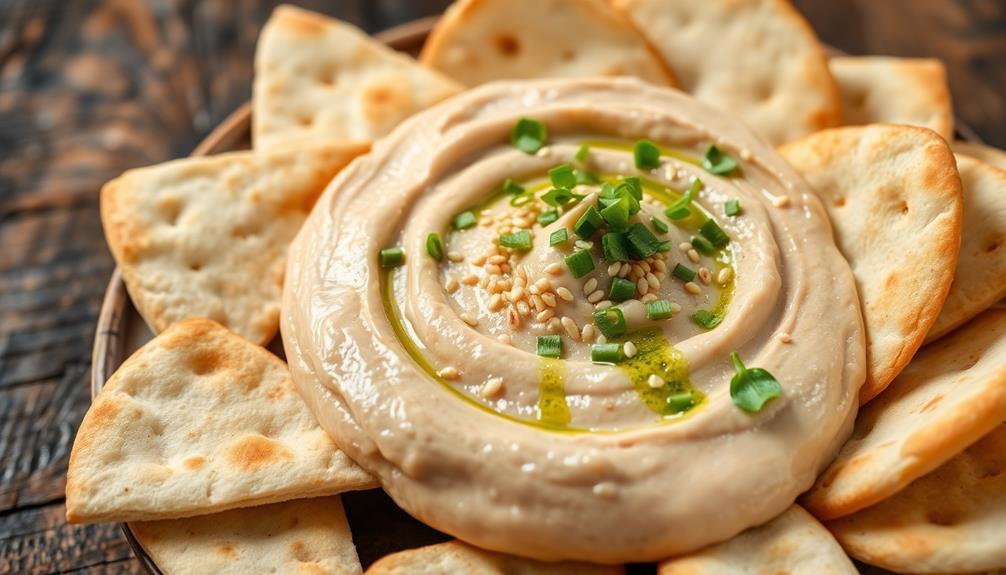
Next, add the tahini to your food processor. Tahini is a paste made from ground sesame seeds, and it's a key ingredient in hummus that provides a subtle nutty flavor and smooth, creamy texture. Start with 2-3 tablespoons of tahini and add more to taste if desired.
Make sure to scrape down the sides of the food processor as you go, ensuring all the ingredients are fully incorporated. The tahini will help bind the chickpeas together and create that signature hummus consistency.
Once the tahini is added, process the mixture for an additional 30 seconds to 1 minute, until it's smooth and creamy.
Taste and adjust the amount of tahini as needed, keeping in mind that the flavor will mellow out as you continue adding the remaining ingredients.
Step 3. Add Garlic and Lemon Juice
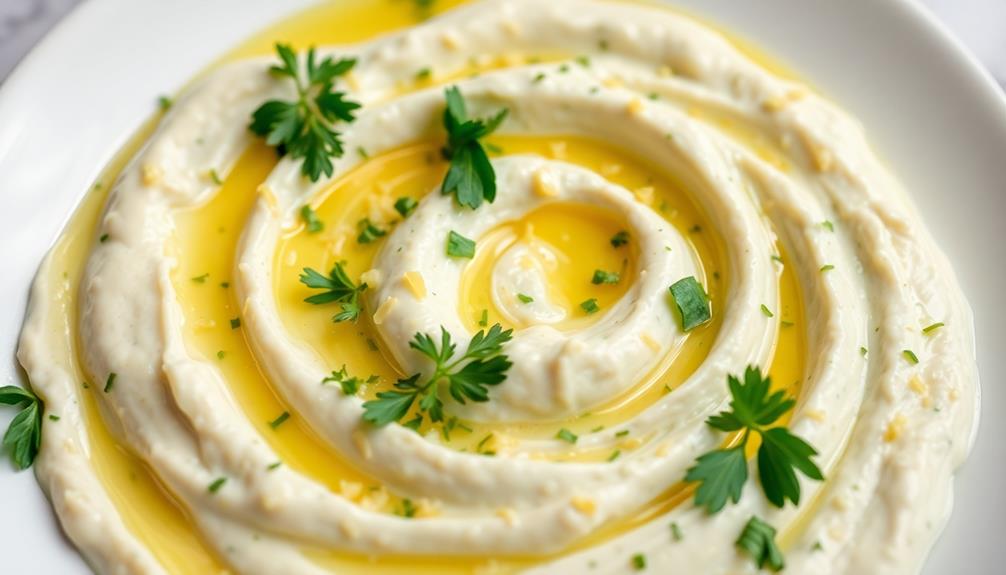
Now that the tahini is incorporated, it's time to add the garlic and lemon juice. Minced garlic will provide a bold, savory flavor, while freshly squeezed lemon juice will lend a bright, tangy note to balance out the richness of the chickpeas.
For best results, use 3-4 cloves of fresh garlic, minced or pressed. This amount of garlic will give the hummus a pronounced yet not overpowering garlicky taste. As for the lemon, start with the juice of 1 small lemon, about 2-3 tablespoons, and adjust to your preferred level of tanginess.
Add the minced garlic and lemon juice to the food processor and blend until fully incorporated. Taste the hummus and add more lemon juice if you desire a stronger citrus flavor.
Alternatively, add a pinch of salt if you'd like to enhance the overall seasoning. Continue blending until the hummus reaches your desired smooth and creamy consistency.
Step 4. Blend Until Smooth Consistency
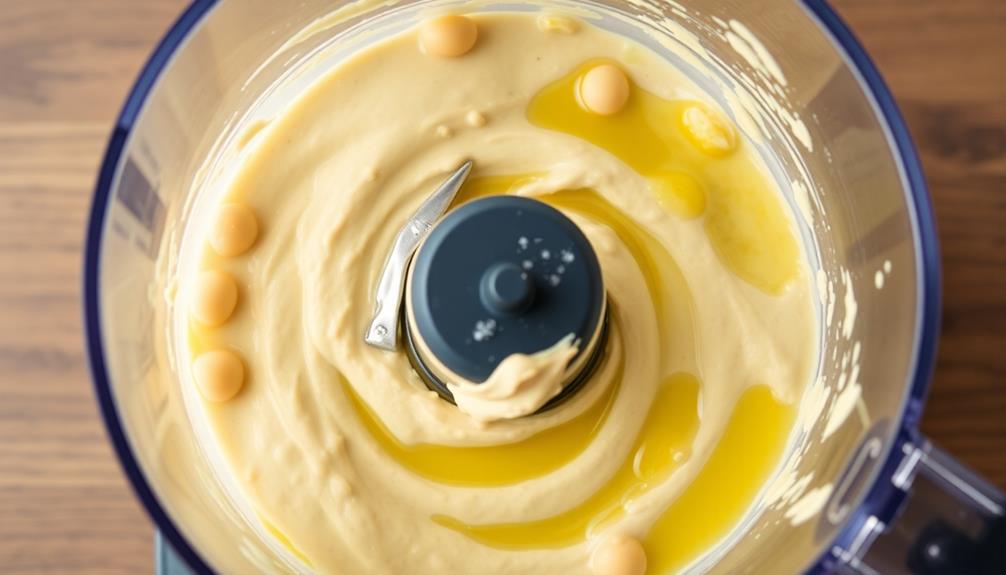
With the garlic and lemon juice incorporated, you'll want to blend the hummus until it reaches a smooth, creamy consistency. This is a crucial step in achieving the signature hummus texture.
Start by adding the garlic-lemon mixture to a food processor or high-powered blender. Turn on the machine and let it run for 2-3 minutes, stopping occasionally to scrape down the sides.
The key is to blend the hummus long enough to break down the chickpeas into a soft, uniform puree. You'll know it's ready when the mixture becomes silky smooth, with no visible chunks or grittiness. Depending on the power of your appliance, this may take a bit of time and patience.
Once the hummus reaches the desired consistency, you can taste it and adjust the seasoning as needed. Add a bit more lemon juice for tang, or a pinch of salt to enhance the flavor.
With the perfectly blended hummus, you're now ready to transfer it to a serving bowl and enjoy!
Step 5. Season With Spices
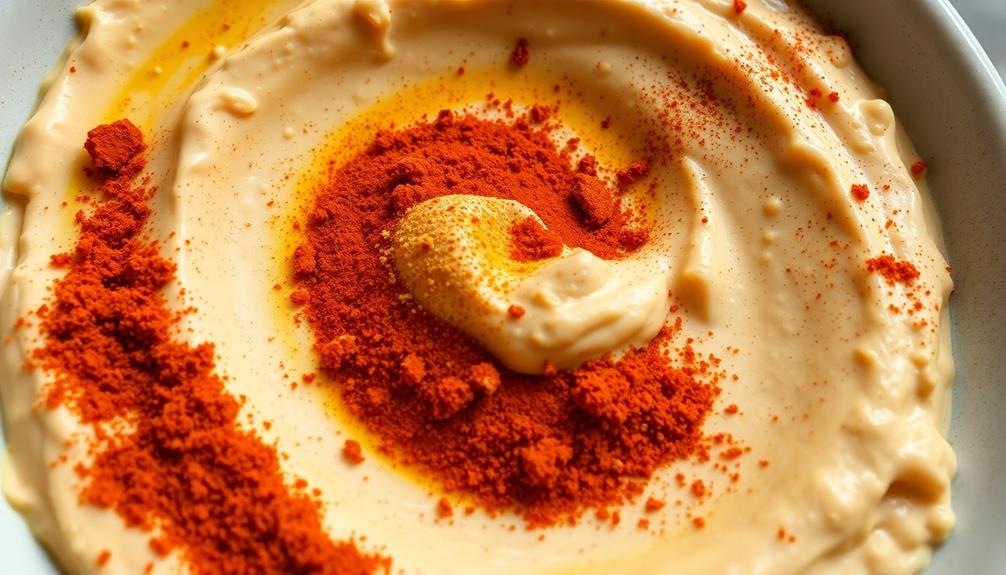
Once the hummus has reached the perfect creamy texture, it's time to season it with some aromatic spices. The right blend of seasonings can elevate your homemade hummus, adding depth of flavor and complexity to this beloved dip.
To enhance its nutritional profile, consider adding a tablespoon of chia seeds, which are a rich source of dietary fiber and can aid digestion and regularity Chia Seeds and Digestive Health.
First, consider the classic flavors of cumin and paprika. A teaspoon or two of each lends a warm, earthy note that complements the chickpeas beautifully.
For an extra burst of brightness, a squeeze of fresh lemon juice or a tablespoon of lemon zest can really make the flavors pop.
Don't be afraid to experiment with other spices as well. A pinch of cayenne pepper or chili powder can add a subtle kick, while a sprinkle of garlic powder or minced fresh garlic enhances the savory qualities.
You can also try herbs like parsley, cilantro, or dill to create a more herbal profile.
Taste your hummus after each addition and adjust the seasonings to your personal preference. The key is to find the perfect balance of flavors that tantalizes your taste buds.
Final Thoughts
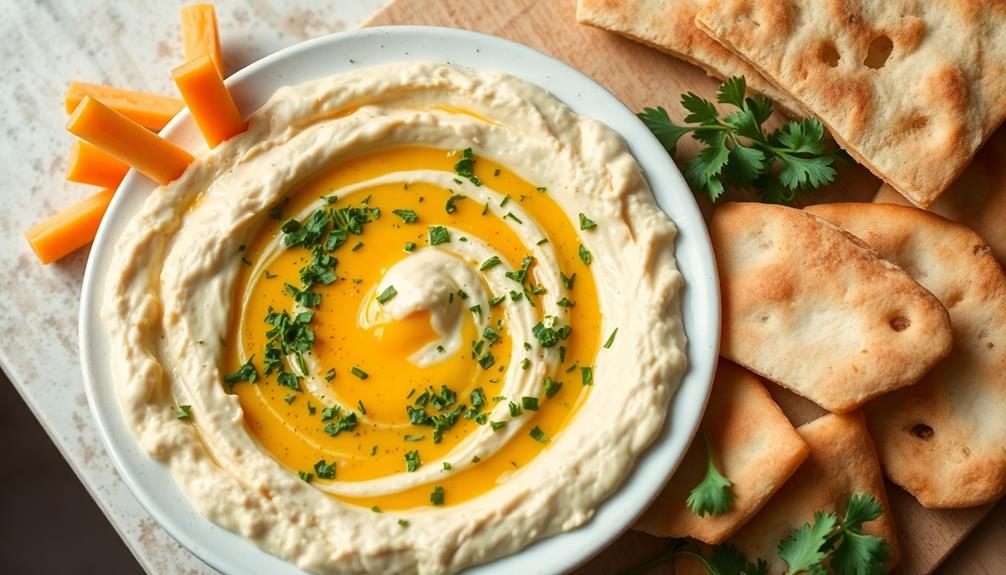
Homemade hummus is a delightful and versatile dish that can elevate any meal. With its creamy texture and bold flavors, it's a fantastic addition to your culinary repertoire. Whether you're hosting a gathering or looking for a healthy snack, this homemade hummus is sure to impress.
One of the best things about making your own hummus is the ability to customize it to your taste. Experiment with different spice blends, roasted vegetables, or even add-ins like pesto or sun-dried tomatoes. The possibilities are endless, allowing you to create a unique hummus that caters to your personal preferences.
Beyond its delicious flavor, homemade hummus is also a nutritious choice. Chickpeas, the main ingredient, are packed with protein, fiber, and essential vitamins and minerals. By preparing it at home, you can control the ingredients, ensuring that your hummus is made with wholesome, high-quality components.
With this easy-to-follow recipe, you'll be well on your way to enjoying the rich, creamy goodness of homemade hummus. Embrace the joy of crafting your own version and savor the satisfaction of a job well done.
Frequently Asked Questions
Can I Use Canned Chickpeas Instead of Dried?
Yes, you can use canned chickpeas instead of dried ones. Canned chickpeas are already cooked and ready to use, which makes the process easier and quicker. Just be sure to rinse and drain them before adding them to your hummus recipe.
How Long Does Homemade Hummus Last in the Fridge?
Homemade hummus can typically last 3-5 days in the fridge when stored properly in an airtight container. The freshness will depend on the ingredients used and how well you've refrigerated it, so be sure to check for any changes in smell or texture.
Can I Make Hummus Without Tahini?
Yes, you can make hummus without tahini. While tahini is a traditional ingredient, you can substitute it with ingredients like olive oil, yogurt, or even nut butters to achieve a similar creamy texture and flavor.
How Can I Make Hummus Thicker or Creamier?
To make your hummus thicker and creamier, add more chickpeas or tahini. You can also try blending the mixture for longer or adding a bit of olive oil or lemon juice. Adjust the consistency to your liking.
What Are Some Tasty Toppings for Homemade Hummus?
You can top your homemade hummus with a variety of tasty toppings. Some ideas include roasted red peppers, kalamata olives, toasted pine nuts, chopped fresh herbs, crumbled feta cheese, or a drizzle of high-quality olive oil and a sprinkle of paprika.



